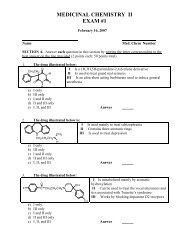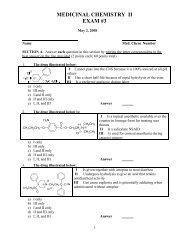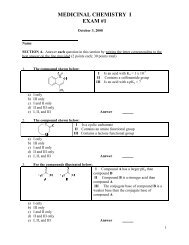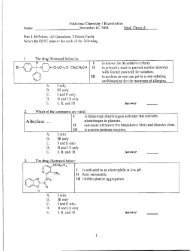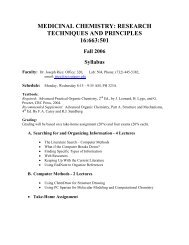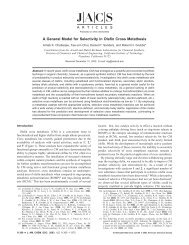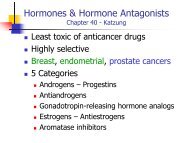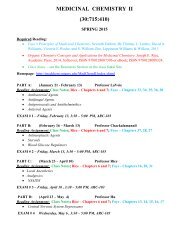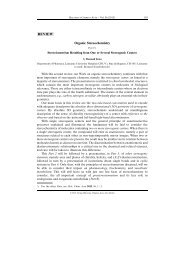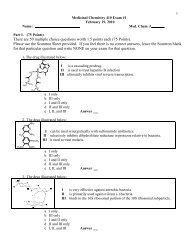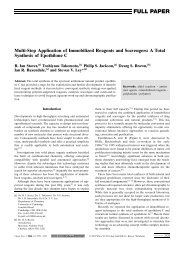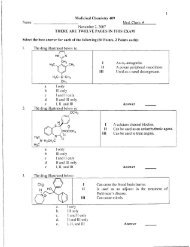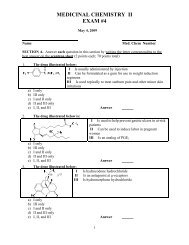Baldwin's Rules - Department of Medicinal Chemistry
Baldwin's Rules - Department of Medicinal Chemistry
Baldwin's Rules - Department of Medicinal Chemistry
Create successful ePaper yourself
Turn your PDF publications into a flip-book with our unique Google optimized e-Paper software.
Chemical Reviews REVIEW<br />
Table 21. SOMOs for the Reacting Radicals, Activation<br />
Barriers, Reaction Energies, and Intrinsic Barriers<br />
(in kcal/mol) for 5-exo-dig and 6-endo-dig<br />
Cyclizations <strong>of</strong> Phenyl-Substituted Vinyl Radicals a<br />
a All values in kcal/mol and ring-closing bonds are shown in red<br />
(B3LYP/6-31G** level).<br />
substituents and are still stabilized by benzylic conjugation. Here,<br />
both steric and thermodynamics combine to further decrease the<br />
5-exo barrier, accounting for the 5-fold increase in the kinetic<br />
pereference for this pathway (>6 kcal/mol) relative to the<br />
competing 6-endo-dig closure in comparison with the preference<br />
for the entries 3 and 5 (∼1.3 kcal/mol).<br />
Note that for the last two cases (Table 21), intrinsic barriers do<br />
not change and calculated barriers are only affected by different<br />
reaction thermodynamics. The intrinsic barriers for 5-exo cyclizations<br />
(entries 3 and 5) are identical and differences in the<br />
overall activation barriers are solely due to the thermodynamic<br />
component (loss <strong>of</strong> benzylic conjugation in the first case). In<br />
contrast, the 6-endo intrinsic barrier increases for the latter case<br />
which suggests that steric interaction between the terminal<br />
substituents is already present at the TS stage.<br />
Interestingly, the intrinsic barriers for entries 2 and 4 are also<br />
similar, suggesting that the deactivating effect <strong>of</strong> benzylic conjugation<br />
is compensated by the difference in hybridization and<br />
geometry. Aryl-substituted radicals have very little s-character<br />
and almost linear geometry at the radical center, whereas simple<br />
vinyl radicals have significant amount <strong>of</strong> s-character and are<br />
noticeably bent. Besides the usual consequences for chemical<br />
reactivity and orbital energies, hybridization also controls<br />
molecular geometry and determines the direction in which<br />
the radical orbitals are projected in space (the valence angles),<br />
as well as the relative size <strong>of</strong> the two lobes <strong>of</strong> a nonbonding<br />
orbital. 166 Such differences in the projection trajectory should<br />
have stereoelectronic consequences for the attack at the acetylene<br />
π-system (see section 2.5.2).<br />
On the basis <strong>of</strong> the above results, Alabugin et al. developed a<br />
radical cyclization cascade transforming polyynes into conjugated<br />
structures similar to those present at the tip <strong>of</strong> carbon<br />
nanotubes. When triyne molecules are capped with either phenyl,<br />
p-tolyl, or trimethylsilyl groups, the radical cascade proceeded<br />
smoothly in ∼70% yields (Scheme 44). 167 The success <strong>of</strong> the<br />
cascade relies upon the regioselective intermolecular attack <strong>of</strong> the<br />
Scheme 44. 5-exo-dig/6-exo-dig Radical Cascade Initiated by<br />
Regioselective Tributyltin Radical Addition to the Center Triple<br />
Bond<br />
Bu3Sn radical at the central triple bond. A vinyl radical, produced<br />
in the intermolecular step, is trapped selectively 5-exo-dig cyclization.<br />
This step is critical for the initiation <strong>of</strong> the cascade and is<br />
completely regioselective: no cyclic products derived from the<br />
6-endo closure <strong>of</strong> the initial radical has been observed. The resulting<br />
vinyl radical is trapped by the third alkyne in a 6-exo-dig<br />
cyclization. In the case <strong>of</strong> phenyl, p-tolyl, and p-anisyl, the fourth<br />
step <strong>of</strong> the cascade is proposed to be cyclization upon the aromatic<br />
ring followed by a 1,5 H-translocation and aromatization to give<br />
the final polycyclic structure. When the triyne is capped with TMS,<br />
the fourth step consists <strong>of</strong> hydrogen abstraction from a silyl methyl<br />
and subsequent 5-endo-trig cyclization and aromatization to yield<br />
the final product.<br />
Another interesting radical cascade cyclization results from the<br />
reaction <strong>of</strong> an aryl isothiocyanate with an o-phenylethynyl aryl<br />
radical (created from the corresponding diazonium tetrafluoroborate).<br />
168 Higher yields were attained when the arene ring <strong>of</strong> the<br />
radical species is with a cyano group substituted para- to the<br />
radical (Scheme 45). The resulting carbon-centered radical<br />
cyclizes in a 5-exo-dig fashion, which outcompetes the Rfragmentation<br />
<strong>of</strong> the aryl sulfanyl radical. Unlike the previous<br />
examples, the 5-exo closure, rather than the 6-endo, provides an<br />
aromatic product and, accordingly, no 6-endo products were<br />
detected.<br />
Scheme 45. Formation <strong>of</strong> Isomeric Quinoline Structures<br />
Resulting from a Radical Cascade Initiated by Addition <strong>of</strong> an<br />
Aryl Radical to the Carbon Sulfur Double Bond<br />
3.3.2. Anionic Cyclizations (Table 22). As with the smaller<br />
analogs, 5-exo-/6-endo-dig closures <strong>of</strong> the parent anionic systems<br />
exhibit lower intrinsic and activation barriers for exocyclic<br />
closure. Unique to this system, however, are the similar exothermicities<br />
for both exo- and endocyclic closure. While the conversion<br />
<strong>of</strong> a weaker bond into a stronger bond (π-bond f σ-bond)<br />
and the concomitant transformation <strong>of</strong> an alkyl anion into a more<br />
stable vinyl anion makes carbanionic closure effectively irreversible,<br />
closure <strong>of</strong> oxygen anions, however, are either thermoneutral<br />
or weakly endothermic (Figure 20 and Table 23). 24<br />
The 5-exo trajectory <strong>of</strong> carbanionic closure approaches that <strong>of</strong><br />
the intermolecular angle <strong>of</strong> attack, and because <strong>of</strong> the longer<br />
linking chain within this system, the endocyclic transition state<br />
now attains an obtuse trajectory (Table 24).<br />
AA dx.doi.org/10.1021/cr200164y |Chem. Rev. XXXX, XXX, 000–000



